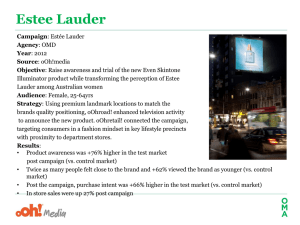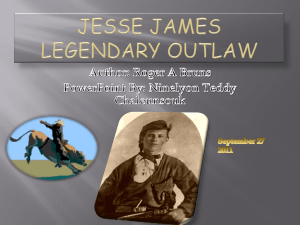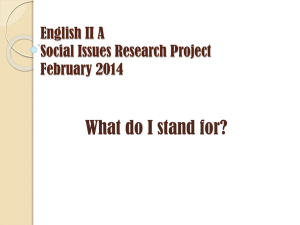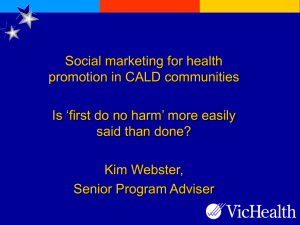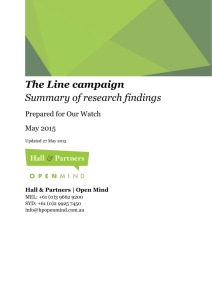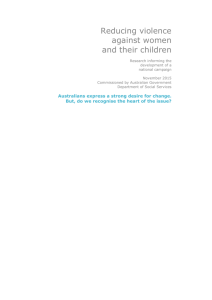THE LINE Campaign
advertisement
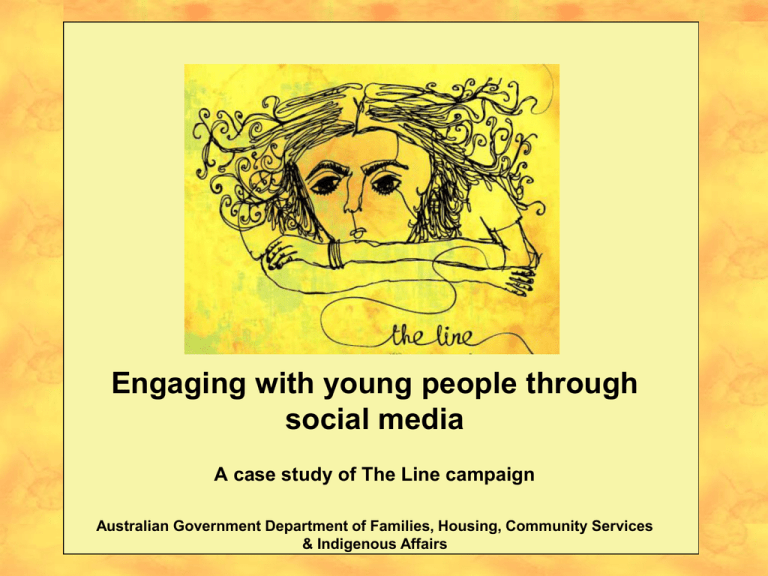
Engaging with young people through social media A case study of The Line campaign Australian Government Department of Families, Housing, Community Services & Indigenous Affairs The Line Social Marketing Campaign • What is it? – 4 year social marketing campaign – launched June 2010 – Targets 12 to 20 year olds and their influencers – Seeks to encourage respectful relationships and bring about change to attitudes and behaviours which support violence – Uses media and language young people relate to – It encourages young people to discuss and debate relationship behaviours and issues The Line Social Marketing Campaign • Campaign background – National Plan to Reduce Violence against Women and their Children (2010-2022) – Primary Prevention approach – Part of a broader strategy across the nation – Positive & respectful attitudes support freedom from violence An informed approach • Developmental research determined who would benefit most from the campaign and how • Qualitative Research – July 2009, 42 ‘mainstream’ focus groups, 12 CALD focus groups, and 18 Indigenous focus groups • Quantitative Research – September 2009 2,800 online surveys – Age group: 12-65 year olds • Benchmarking and Tracking Research – Every 6 months An informed approach • Who do we want to reach? – Primary audience = boys and girls aged 12-20 years – Secondary audience = Parents, teachers, people who work with young people aged 12-20 years • How do we reach them? – Non-authoritarian and non-traditional approach – Debate and discussion through social media An informed approach What are the campaign’s key messages? – Australia has zero tolerance towards violence against women and children - violence and disrespectful behaviour is not acceptable – Respect is the basis of all good relationships – Verbal abuse, sexual bullying, controlling behaviour and harassment are all forms of disrespect and violence, and – Help is available if you experience violence, or if you need help to stop being violent. An informed approach • What should our engagement approach aim to achieve? – Encourage young people to realise they may personally experience unacceptable relationship behaviours – Demonstrate benefits associated with positive behaviour – Deliver personally relevant messages to encourage, motivate and support the primary target groups to reconsider the importance of respectful relationships – Encourage young people to assess their own relationship behaviour – Encourage young people to change their own behaviours where necessary – Encourage discussion on relationship grey areas An informed approach • Which channels have we used? – Heavy digital and online focus • Social media • Website advertising • Search engine optimisation – Central website – www.theline.gov.au – Magazines – advertising and integration activities – Radio – advertising and integration activities Digital and online focus - The Line Website • www.theline.gov.au • Share the Line (blog) • Draw your own line • FAQ (commonly faced issues) • Separate Indigenous and CALD pages • Have your say (polls) • Webisodes • Music and more Digital and online focus - The Line Facebook page • www.facebook.com/theline • Status updates • Cross link to website FAQs and polls • Discussions tab Digital and online focus - Webisodes • Webisodes – Short animations that depict a group of characters in a range of situations that could develop in to ‘crossing the line’ – Mechanism to engage young audiences in the scenarios and encourage them to think about what their own responses in the situations would be – Provide content that can be easily shared while encouraging key behaviours and actions – Underwent concept testing and recommendations from this research were incorporated into the scripts Digital and online focus – Webisodes Party Girl We will insert the video for Party Girl in here – it Digital and online focus - Webisodes will run straight through all three response options in order without stopping. What’s been achieved so far? • Over 65,000 Facebook fans • Average of 5000 votes each week • 39% of people recognise the campaign • Increased recognition by males • 77% done something positive • 76% intend to do something positive • Learned that around half of 12-24 year olds have been bullied in last 6 months • Long term vision What’s next • 2011-12 – New competitions and music – The “zine” – New ambassadors in the music industry – Weekly online discussions – “Talk the Line” – Identified topics – Linking to other players in the field What we have learnt about using social media • Open to the public • Champions, detractors, graffiti, privacy, vulnerabilities • Moderation is necessary and expensive • Risks – reputation, responding to crises, lack of engagement • Approach & hours of coverage to manage risk What we have learnt about using social media • Online risk mitigation advice • Community management approach • Intervention v/s self-moderation • Maximising moderation hours within budget • Appropriate support for vulnerable users Other online technologies Making social media work for you • Social media can be resource intensive • Great tool for engaging, especially with young people • Costs proportionate to what, how much and acceptable risk • Find and use what’s already out there • Join the conversation! Fiona Smart Branch Manager Safety Taskforce Branch Office for Women Department of Families, Housing, Community Services and Indigenous Affairs fiona.smart@fahcisa.gov.au Thank you. Any questions?




